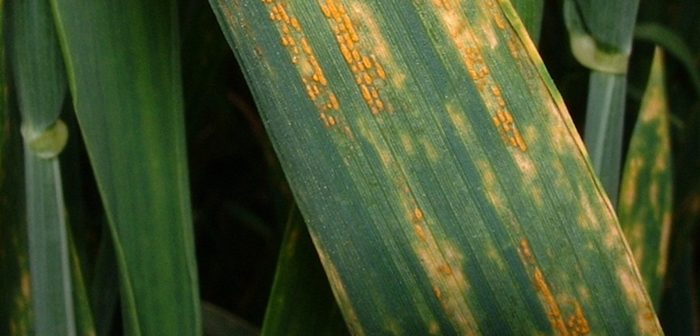A well planned T0 fungicide should be the foundation to effective disease control in wheat crops this spring, leading agronomy firm Hutchinsons says.
The importance of this early spray can sometimes be overshadowed by later T1 and T2 fungicides, but it is vital for controlling disease that established over winter. It also “buys time” and reduces pressure on subsequent sprays, so has valuable benefits even where disease pressure appears low.
T0 timing is not directly determined by growth stage, although fungicides are typically applied from late tillering to the start of stem extension (GS 25-30). A slightly earlier spray may be required if disease pressure is very high, particularly from yellow rust.
Fungicide choice depends on many factors, such as variety susceptibility, local conditions and diseases present, but generally Septoria remains the priority in most situations, says technical director Dr David Ellerton.
“Fungicides don’t have the curative control they once did, so we cannot let Septoria get established and end up in a curative situation by T1. Once Septoria is established it’s very hard to take out.
“A multisite protectant is cost-effective and I believe should be routine at T0 to protect leaf 4 and give leeway to following fungicide applications should weather delay T1 sprays.”
Chlorothalonil is the strongest on Septoria, however folpet offers a good alternative with a slight edge against rust, he notes.
T0 has added importance in SW
Southwest England suffers particularly high Septoria risk, which is why Hutchinsons agronomist Ryan Came-Johnson puts more emphasis on the T0 fungicide for wheat crops across his region around the Cornwall and Devon border.
“Because the pressure is so high in this area, we’ve got to keep Septoria out from the start, otherwise it can cause real problems.”
In last year’s mild season, that meant an “extraordinarily early” T0 spray applied in mid-February to some of the most forward crops, however this year is looking more normal, with most sprays expected to be applied around mid-March.
“A lot of crops were drilled later this season and the weather hasn’t been as mild as last year, so wheat isn’t as advanced [as in 2017]. Most crops look fairly clean at the moment because we haven’t got the lush growth and warm, damp microclimate within the canopy for Septoria to develop. However, a lot depends on the weather over the next month or so.”
He too favours a chlorothalonil base to T0 sprays, with a chlormequat-based growth regulator if required. Other actives may be included for specific diseases, such as mildew, he says.
Additional disease targets
Mildew and yellow rust are the other main targets at T0, especially when growing susceptible varieties, or in particularly high-risk situations.
For curative mildew control, fenpropimorph or cyflufenamid should be included with the T0. In protectant situations in high-risk areas (e.g. western England, Scotland, or on organic soils), or with susceptible varieties, consider proquinazid, Dr Ellerton says.
Where rust pressure is high and curative control is required, a rust-active triazole should be included at T0, such as tebuconazole, cyproconazole or epoxiconazole.
“Even where a variety has adult resistance, this often doesn’t kick in until later in the season when the damage to yield may already be done. If it’s a new strain of rust, varietal resistance may be overcome altogether. So if yellow rust is present, it pays to knock it out early when it is relatively easy to control,” says Dr Ellerton.
Strobilurins such as pyraclostrobin or azoxystrobin are another option in protectant situations, that can reduce reliance on azole chemistry and potentially benefit rooting and nitrogen scavenging, he says.
“Strobilurins don’t have the curative action that triazoles offer, but they can be a good alternative, especially if triazoles are going to be used at later timings. The rooting benefits may be particularly useful on more backward crops or drought-prone soils.”
Fusarium is another disease to consider at T0. In high-risk situations (e.g. maize in the rotation), Dr Ellerton suggests it may be worth including tebuconazole to reduce disease pressure and save other fusarium-active chemistry, such as prothioconazole, for later sprays.
He also reminds growers the optimum interval between sprays should not exceed three to four weeks to maintain protection, but T1 and T2 sprays must be applied at the correct growth stage.
“If you apply the T0 early, you need to wait for the correct T1 timing to fully protect leaf three when it emerges.”
Mr Came-Johnson adds: “It’s important to work fungicide timings back so you’re not stretching spray intervals too far.”
T0 fungicide tips
- Septoria remains top priority
- Early protectant control reduces curative pressure on later sprays
- Include a multi-site active as routine
- Plan sprays/tank mixes according to varietal susceptibility and disease pressure
- Consider rust and mildew
- Utilise a range of chemistry for resistance management.-ends-




